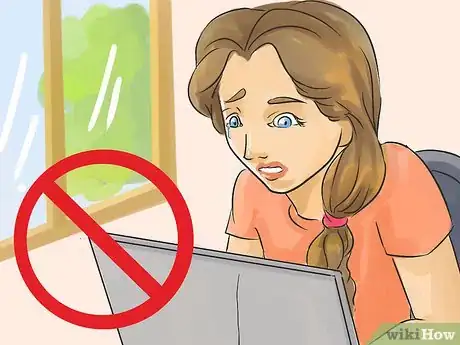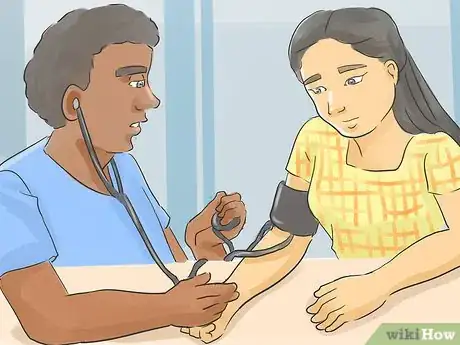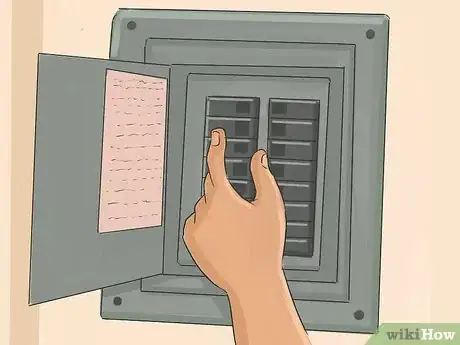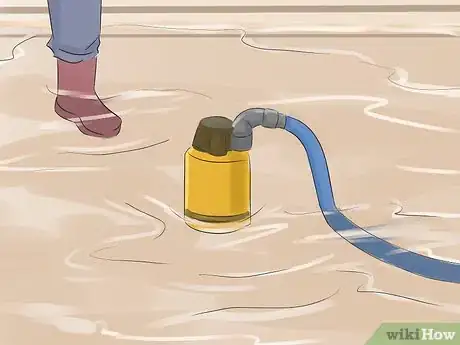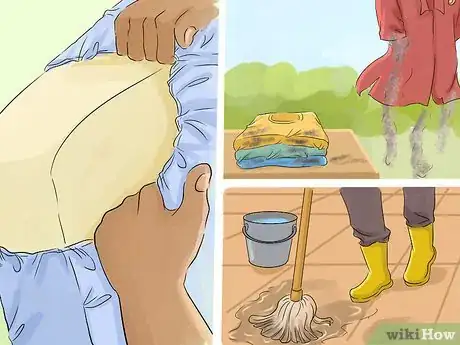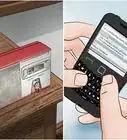This article was co-authored by Paul Chernyak, LPC. Paul Chernyak is a Licensed Professional Counselor in Chicago. He graduated from the American School of Professional Psychology in 2011.
There are 13 references cited in this article, which can be found at the bottom of the page.
This article has been viewed 83,480 times.
After a flood, your home and its contents may look beyond hope and you may be feeling anxious, confused, and frightened. These feelings are perfectly natural, but with work you can overcome them and feel safe and confident in your home once again. Take care of yourself, reach out to friends and professionals for help, and work to slowly rebuild your home in order to fully heal after a flood crisis.
Steps
Tending to Your Emotional Health
-
1Remember that your feelings are normal. Whether you’re feeling grief, disbelief, shock, stress, irritability, apathy, anger, sadness, or any other negative emotion, know that you’re not alone, and you’re not wrong for feeling that way. These feelings are not a sign of weakness or failure, but a human reaction to what you’ve just experienced.[1]
- Grief is a common reaction to experiencing a disaster. Even if there was no loss of life, it is normal to feel grief after losing your home or possessions, much the way you would after losing a loved one.[2]
-
2Heal at your own pace. Not everyone reacts or heals in the same way. As much as possible, try to avoid comparing yourself to others around you, whether they’re your neighbors, friends, or even family. Do what you need to do, at the pace that feels right for you.[3]
- Pick one task at a time, and focus on that instead of trying to tackle everything at once.
- Just because those around you don’t seem stressed doesn’t mean they aren’t. Remember that everyone deals with stress in their own way.
Advertisement -
3Talk to others who were affected. Discuss what happened, talk together, and share your anxieties with those closest to you. Allow space for releasing the emotions you feel, whether they’re sadness, anger, frustration, helplessness, or something else. Realize that other people feel similarly, and that you’re not alone. Don’t be afraid to cry; crying is a natural response to a disaster, and is also a great way to release pent-up emotions.[4]
-
4Seek professional help from a crisis counselor. Volunteer agencies like the Red Cross and the Salvation Army offer special outreach programs and crisis counselors that can help you work through your experience.[5]
-
5Make sure you eat and sleep enough. You won’t be able to heal if you don’t take care of yourself physically. Maintain healthy eating and sleeping, and ensure you’re drinking plenty of safe water in the days and weeks following the flood.[6]
-
6Re-establish daily routines slowly. One way to heal is to return to things that are familiar and comfortable. Do laundry, wash the dishes, and watch TV if you can. If you have a temporary place to live, or if your house has been declared safe to live in, start cleaning and go grocery shopping. Go about as many daily tasks as possible and include things that make you happy in your day to day activities.[7]
-
7Avoid major news sources and images of the flood. Looking at the flood and hearing it discussed on an impartial level can often contribute to major stress and shock. If possible, avoid news sources and images, so you can cope with the flood at your own pace.[8]
-
8Seek out positivity. If you do pay attention to the news, make an effort to find positive stories, such as accounts of people in the community coming together to help each other. Spend time with people who are positive, upbeat, and working to change things for the better.
-
9Spend time with friends and family. Now more than ever, band together with the people who love you. Don’t be afraid to ask for help, and be honest with your friends and family. Tell them if you need time, if you need advice, of if you just need a comforting presence or a place to stay. In the midst of confusion, don’t be afraid to rely on your friends and family to be your rock.[9]
-
10Practice gratitude. While it can be hard to see when you are struggling to cope with a crisis, good things can come from any situation. Take a moment to feel grateful for the positive parts of your experience – for example, think of the supportive people in your life, and consider how the flood may have brought your family or your community together.
- Remember that while things can be replaced, people cannot. Be grateful for your friends, family, and community.
Remaining Safe
-
1Find a safe, warm place for you and your family to stay. If the flood damaged or destroyed your home, don’t spend any time inside the house, as there could be structural damage or other issues. Find local, safe shelter like schools and town halls. Do not enter any building that is still flooded until local building officials have inspected it for safety.[10]
-
2Attend to any medical needs immediately. If you were injured during the flood, locate an American Red Cross or other volunteer station and get immediate medical help. Even minor wounds or seemingly small illnesses can be dangerous when added to a flood situation.[11]
-
3Find safe drinking water. Drink only from bottled waters that have not been contaminated by flood waters. Do not drink from a private well or other potentially contaminated water source (like sink water) until local officials have announced that the water is safe to drink.[12]
-
4Do not attempt to drive through flooded areas. Just 1 foot (0.30 m) of moving water can sweep a vehicle away. Avoid flood areas and follow all safety instructions including weather updates, emergency instructions, and evacuation orders.[13]
-
5Do not enter your home until it is safe to do so. Your home could be unsafe for reasons you can and can’t see. Cracks in the foundation, gas leaks, broken power lines, and leaking chemicals could all contribute to an unsafe location. Do not enter until you receive permission to do so.[14]
Repairing Your Home after the Flood
-
1Keep power off until an electrician can inspect your home. All electrical equipment must be checked and dried before it can be turned on again. If you’re not sure if the electricity is off, do not enter your home.[15]
-
2Contact your insurance company ASAP. The sooner you can talk to your agent, the sooner your claim will be filed. Send your insurance company pictures of everything that has been damaged (both inside and outside of the house). File a “Proof of Loss” form within 60 days of the flood in order to claim your flood insurance.[16]
- Depending on how serious your flood was and what type of insurance you have, your insurance company might also cover the cost of clean up.[17]
-
3Address immediate problems. Remove all wet contents immediately to prevent mold. If there are any severe issues like holes in your wall or broken windows, patch these with plastic sheets, duct tape, and wood strips. Brace any weak areas or sagging floors with plywood. Pump water out from flooded basements.[18]
- When pumping water out of your basement, pump out about ⅓ of the water volume each day to avoid structural damage to your home or basement.[19]
-
4Ventilate and dry your home. Open windows and doors to help the inside dry out as much as possible. If you live somewhere very humid, or the ventilation system isn’t working for your home, consider using a dryer or air mover. Make sure your carpets, walls, ceilings, and floors are dry as quickly as possible.[20]
-
5Create a recovery plan. A recovery plan is a list of jobs that need to be done in order to get your house repaired after the flood. Planning can help you save time and money, and it can also put you back on track. When creating a recovery plan, be mindful of what you can and can’t do, and don’t push yourself too far or too fast.[21]
-
6Seek government emergency funding through DisasterAssistance.gov. Depending on the scope and damage of the flood, your community might be eligible for state, provincial, or federal aid. Search online to discover if any funds have been freed up to assist victims in your flood area.[22]
-
7Tackle one room at a time. Parse your home into manageable chunks and work your way through it. Start each room in the corner that received the most damage, and work your way out from there. Use a disinfectant spray to clean any surfaces that came in contact with water and wash clothing and bedding with hot water. Be patient, and trust that, with time and work, your home will improve.[23]
Expert Q&A
-
QuestionDo you need to reimburse emergency funds?
 Paul Chernyak, LPCPaul Chernyak is a Licensed Professional Counselor in Chicago. He graduated from the American School of Professional Psychology in 2011.
Paul Chernyak, LPCPaul Chernyak is a Licensed Professional Counselor in Chicago. He graduated from the American School of Professional Psychology in 2011.
Licensed Professional Counselor It would be wise to keep emergency funds and replenish them whenever possible. Emergencies can occur at any time.
It would be wise to keep emergency funds and replenish them whenever possible. Emergencies can occur at any time.
Warnings
- Do not drink any water you are not sure is safe.⧼thumbs_response⧽
- Do not walk through flowing water that is more than 6 inches (15 cm) deep.⧼thumbs_response⧽
- Look before you step.⧼thumbs_response⧽
- Stay away from power lines and electrical wires.⧼thumbs_response⧽
- Avoid standing in still water.⧼thumbs_response⧽
- Be alert for gas leaks.⧼thumbs_response⧽
References
- ↑ http://www.mentalhealthamerica.net/conditions/coping-stress-natural-disasters
- ↑ https://www.helpguide.org/articles/grief/coping-with-grief-and-loss.htm
- ↑ http://www.state.nj.us/emergency/flood/stress.html
- ↑ https://www.fema.gov/coping-disaster
- ↑ http://www.state.nj.us/emergency/flood/stress.html
- ↑ https://wvde.state.wv.us/healthyschools/documents/QuickBriefonRecoveryAfteraFloodforTeachersandParents.pdf
- ↑ http://www.mentalhealthamerica.net/conditions/coping-stress-natural-disasters
- ↑ http://www.mentalhealthamerica.net/conditions/coping-stress-natural-disasters
- ↑ https://www.fema.gov/coping-disaster
- ↑ http://www.susquehannafloodforecasting.org/before-during-after.html
- ↑ http://www.susquehannafloodforecasting.org/before-during-after.html
- ↑ http://dnr.wi.gov/emergency/floodcoping.html
- ↑ https://www.ready.gov/floods
- ↑ https://www.sylvane.com/how-to-handle-a-flood.html#during
- ↑ http://www.susquehannafloodforecasting.org/before-during-after.html
- ↑ https://www.fema.gov/media-library/assets/documents/9343
- ↑ https://www.gov.je/StayingSafe/HomePersonal/KeepingHomeSafe/Pages/Flooding.aspx
- ↑ https://www.redcross.org/images/MEDIA_CustomProductCatalog/m4540081_repairingFloodedHome.pdf
- ↑ http://www.susquehannafloodforecasting.org/before-during-after.html
- ↑ https://www.sylvane.com/how-to-handle-a-flood.html#during
- ↑ https://www.redcross.org/images/MEDIA_CustomProductCatalog/m4540081_repairingFloodedHome.pdf
- ↑ https://www.disasterassistance.gov/about-us/overview
- ↑ https://www.gov.je/StayingSafe/HomePersonal/KeepingHomeSafe/Pages/Flooding.aspx






